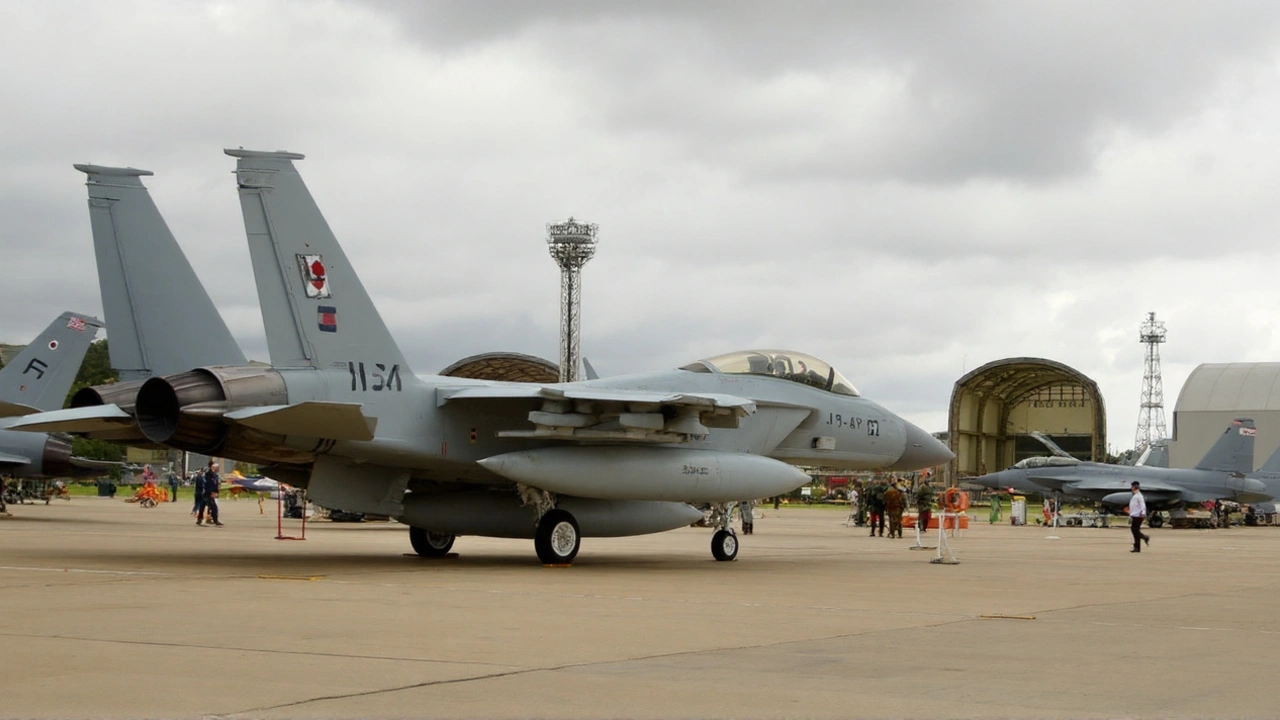
Japan’s fighters in UK skies, a first in 71 years
Two Japanese F-15J Eagle fighters touched down at RAF Coningsby, Lincolnshire, at 16:46 local time on September 18, lighting up a milestone that has been decades in the making. The Japan Air Self-Defense Force (JASDF) jets—serials 22-8936 (JINTEI01) and 42-8946 (JINTEI02) from 2 Kokudan’s 201 Hikotai—arrived with a brief flypast before landing at the home of the RAF Typhoon force. It’s the first time in the 71-year history of Japan’s air arm that its combat aircraft have deployed to Europe.
The visit is the opening chapter of “Atlantic Eagles,” a multi-stop mission that began at Chitose Air Base on Hokkaido. Four F-15Js are assigned to the deployment. The route shows how carefully the operation was planned: staging through Eielson Air Force Base in Alaska, then Goose Bay in Canada, before crossing the Atlantic to Britain. The first pair is now settled at Coningsby; the second pair is set to follow on a rolling timeline shaped by weather, aircraft serviceability, and tanker availability.
Japan did not come light. A modern Kawasaki C-2 transport (tail 58-1218), delivered to the JASDF in March 2025, arrived in the UK on September 17 with maintenance crews and critical kit. A second C-2, plus KC-46 Pegasus and KC-767 tankers, are operating out of RAF Brize Norton to keep the mission moving. The transporters haul what fighters need to fight—or to train far from home: ground power units, tools, spares, test equipment, and a small army of technicians who make the jets reliable day after day.
RAF Coningsby is an apt stage for this first act. It’s one of the RAF’s main Eurofighter Typhoon bases and a key node in Britain’s Quick Reaction Alert network. Its squadrons and the resident Operational Conversion Unit host a steady churn of training and visiting detachments. Slot in two Japanese Eagles and you have the makings of a rich week: dissimilar air combat training (DACT) against Typhoons, refueling drills with RAF tankers, and plenty of ground-crew exchanges to compare how each side keeps fast jets mission-ready.

Why it matters—and what comes next
This deployment took shape after high-level talks between UK Defence Secretary John Healey and Japan’s Nakatani Gen aboard HMS Prince of Wales as the carrier swung through Tokyo under Operation Highmast. The symbolism is clear, but it’s also practical. London has been leaning into an Indo-Pacific tilt since the 2021 Integrated Review, and Tokyo has been widening its circle of defense partners while staying focused on deterrence at home.
Put simply, both countries want their air forces to be able to work together under real-world conditions. That means not just pilots flying against each other, but logisticians dealing with a surge of aircraft on a foreign base; planners syncing airspace, radio, and data links; and maintainers solving the everyday problems that make or break readiness. Doing this in Britain, far from Hokkaido, shows Japan can project and sustain advanced airpower across continents and slot into NATO-style operations.
For Japan, the platform choice matters. The F-15J is the backbone of its air defense fleet, a twin-engine air superiority jet with long legs, a powerful radar, and the payload to carry heavy air-to-air loads and fuel. Many airframes have gone through Japan’s multistage upgrade paths to improve sensors, cockpit systems, and electronic warfare. Tokyo plans to keep a significant portion of the fleet relevant into the 2030s through further modernizations, pairing them with F-35s while it develops the next-generation fighter under the joint UK-Italy-Japan GCAP program.
Moving fighters across the North Pacific and North Atlantic is a test of logistics as much as it is of flying skill. Tankers set the pace. Crews plan routes around weather, divert fields, and tanker tracks, often at short notice. Fighters fly in formation with refuelers, topping up repeatedly to manage fuel and weight. On the ground, the C-2s act like mobile warehouses. They bring spare tires, brake units, avionics boxes, and even spare engines if needed, so a single fault doesn’t strand a jet hundreds of miles from home.
The UK brings its own strengths. Coningsby is built for tempo—large ramps, hardened shelters, and teams used to surges for exercises and QRA. The RAF’s Typhoon force trains to intercept everything from civilian airliners with lost radios to long-range bombers and patrol aircraft testing the edges of UK airspace. Mixing in Japan’s Eagles offers both sides a rare set of radar signatures, tactics, and training problems that you simply cannot recreate with a simulator alone.
Expect the flying to cover the essentials. DACT sorties to stress different radar and missile philosophies. Intercept profiles that replicate the quick thinking needed on QRA. Larger composite air operations to practice timing, communication, and deconfliction. Ground crews will shadow each other’s workflows—turnaround times, fault diagnosis, and data-recording routines—because reliability is where long deployments are won.
The diplomacy is wider than two jets on a British runway. Japan has deepened ties with NATO in recent years as one of the Alliance’s four Indo-Pacific partners. The shared focus is interoperability and a common approach to a rules-based order—how to operate together cleanly in airspace, at sea, and across cyber and space. This trip is a concrete piece of that puzzle, the airpower counterpart to naval port calls and army exercises.
For London, the visit underscores more than a talking point in a strategy document. The UK has been visible in the Indo-Pacific—from carrier strike group deployments to work on the AUKUS submarine pathway—while also hardening its European posture. Hosting Japan’s combat aircraft is a practical way to tie the two theaters together and to show partners in both regions that the “tilt” is backed by flying hours, not just communiqués.
There’s also the industrial angle. The UK and Japan are co-leading GCAP to field a sixth-generation combat aircraft in the mid-2030s with Italy. The people flying and fixing jets together at Coningsby today are the same communities that will need to make GCAP work tomorrow—agreeing on standards, data sharing, and support concepts. Familiarity built on the flightline now pays dividends when the first prototype needs a detachment halfway across the world.
After the UK leg, the Atlantic Eagles deployment heads to Germany, with Laage Air Base expected as the next stop from September 23. Laage is home to Luftwaffe Eurofighters and a major training hub, so the playbook will look similar: DACT, intercept training, and ground-crew exchanges, this time with German counterparts. It’s another chance to align procedures and learn how different European air forces manage alert duties, air policing, and day-to-day flying.
Security messaging is part of this, but both governments have framed the trip around readiness and partnership rather than confrontation. The war in Ukraine has sharpened Europe’s focus on air defense and stockpiles; the Indo-Pacific has its own flashpoints. What unites the UK and Japan here is a desire to be ready with capable allies, to move fast, and to make decisions backed by real-world practice rather than theory.
Zoom out and the first Japanese fighters in Europe look like the start of a pattern, not a one-off. JASDF units have been ranging farther in recent years—to Australia for Bushido Guardian exercises, to the Philippines for combined training, and regularly to Alaska for Red Flag. Every trip teaches lessons in sustainment, airspace coordination, and multinational planning. Each one lowers the friction for the next.
RAF Coningsby and 201 Hikotai have more in common than it seems at first glance. Both guard their home airspace with fast jets on alert. Both have to balance standing tasks with training and modernization. And both are figuring out how to integrate a mixed fleet—legacy air superiority fighters, stealth platforms, and eventually a new generation of networked aircraft—without losing a beat.
Even the quieter details matter. Radios, encryption loads, and data links have to match. Ground handling gear needs adapters. Fuels and lubricants must meet both nations’ standards. Customs paperwork for sensitive spare parts can slow a mission unless it’s squared away weeks in advance. The fact that the first pair of jets arrived on time, flew a tidy flypast, and rolled to a parking spot at Coningsby is the visible tip of a deep planning iceberg.
Japan’s C-2 transports stand out in this story. They’re designed for long-range heavy lift—fast for their class, with a roomy cargo hold and a healthy payload. Using a pair of them for the Atlantic Eagles mission signals Tokyo’s intent to move its own support everywhere its fighters go. That independence matters if you expect to operate alongside partners who may be stretched by other commitments.
As for the F-15J itself, it’s a known quantity but far from dated. The type’s size lets it carry lots of fuel, sensors, and missiles, and its upgrade paths have kept it relevant in the radar and electronic warfare game. The JASDF combines medium- and short-range air-to-air weapons tailored to its mission of defending a wide island chain. When those jets show up at a European base, they bring a different way of solving the same problem set—deterrence through credible, ready airpower.
The week ahead will be busy. Weather windows will be watched, crews will squeeze in sorties, and engineers will chase the little gremlins that always pop up away from home. On September 23, the Eagles are scheduled to lift, refuel, and head for Germany. It’s a short hop compared to the ocean legs they’ve already flown, but it will carry the same message: Japan’s air force can go the distance, and Europe is ready to fly with it.
On paper, “first-ever deployment of Japanese fighters to Europe” reads like a headline from another era. In practice, it’s a snapshot of how the Euro-Atlantic and Indo-Pacific security theaters are knitting together. Not just through summits and statements, but through the sound of afterburners over Lincolnshire and the sight of Japanese ground crews putting chocks under a jet on British concrete.
For the crews, these days will fade into stories about a crisp September sky, a busy ramp at Coningsby, and the odd feeling of seeing katakana tail flashes parked next to RAF roundels. For planners in Tokyo and London, it’s proof that years of paperwork, agreements, and cautious first steps now add up to something that flies.
And for anyone watching the skies, it’s simple: Japanese Eagles in the UK are no longer a what-if. They’re here, they’re flying, and the next time won’t feel historic—it will feel normal.
5 Comments
Write a comment
More Articles

Kalonzo Musyoka Decries Security Withdrawal from Chief Justice Martha Koome: An Unacceptable Threat to Judicial Independence
Wiper leader Kalonzo Musyoka has criticized the withdrawal of Chief Justice Martha Koome's security, calling it a threat to judicial independence. Koome expressed concerns to Interior Cabinet Secretary Kipchumba Murkomen, stating the withdrawal threatens the judiciary's ability to function. Despite police claims of a routine officer replacement, legal groups have condemned the move, highlighting risks to the judiciary's integrity.

Oby Ezekwesili Upholds Old National Anthem Amid Controversy over New Version
Former Minister of Education, Oby Ezekwesili, firmly opposes the newly signed national anthem endorsed by President Bola Tinubu. She pledges to continue singing the old anthem despite the new legislation. This move has sparked widespread debate on patriotism and the country's priorities amid economic challenges.

Sabrina Carpenter and Barry Keoghan Captivate with 'Please Please Please' Music Video
Sabrina Carpenter's latest music video 'Please Please Please' features her rumored boyfriend Barry Keoghan, portraying a chaotic romance with intense drama. The storyline traces Carpenter's plea for stability as Keoghan reverts to crime, culminating in a decisive breakup. The real-life couple's chemistry adds a magical touch, showcased by their significant public appearances since December.
Sagar Monde
September 20, 2025 AT 22:26The F‑15J can hit around Mach 2.5 in level flight